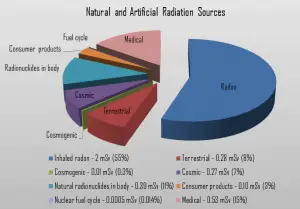There are two distinct groups exposed to man-made radiation sources. The United Nations Scientific Committee on the Effects of Atomic Radiation (UNSCEAR) itemized types of human exposures as:
- public exposure, which is the exposure of individual members of the public and of the population in general
- occupational radiation exposure, which is the exposure of workers in situations where their exposure is directly related to or required by their work
Public Exposure from Man-made Radiation Sources
In general, the following man-made sources expose the public to radiation:
- Medical Exposures (by far, the most significant man-made source)
- Diagnostic x-rays
- Nuclear medicine procedures (iodine-131, cesium-137, technetium-99m etc.)
- Consumer Products
- Building and road construction materials
- Smoking cigarettes (polonium-210)
- Combustible fuels, including gas and coal
- X-ray security systems
- Televisions
- Smoke detectors (americium)
- Lantern mantles (thorium)
To a lesser degree, the public is also exposed to radiation from the nuclear fuel cycle, from uranium mining and milling to disposal of used (spent) fuel. Noteworthy, the public is also exposed to radiation from so called “enhanced sources of naturally occurring radioactive material”. This means also industries such as metal mining, coal mining and power production from coal creates additional exposures due to densification of naturally occurring radionuclides. The public receives some minimal exposure from the transportation of radioactive materials and fallout from nuclear weapons testing and reactor accidents (such as Chernobyl).
For that reason, most regulatory bodies require to limit the maximum radiation exposure to individual members of the public to 100 mrem (1 mSv) per year.
We hope, this article, Public Exposure from Man-made Radiation Sources, helps you. If so, give us a like in the sidebar. Main purpose of this website is to help the public to learn some interesting and important information about radiation and dosimeters.
